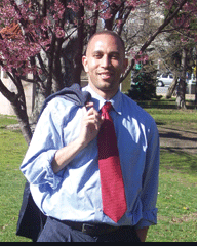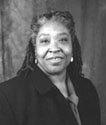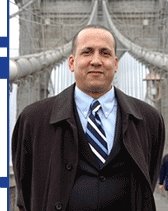So what happened at the candidates’ forum Monday night beyond the brouhaha over Daniel Goldstein’s improper, racially-charged email comment? (See the follow-up in the Daily News, which downplayed the role of Forest City Ratner supporters in accentuating racial division. See further clarification.)
Well, the candidates for the 57th Assembly District displayed their styles before a diverse crowd at the Brown Memorial Baptist Church in Clinton Hill, and it's likely that biography and personality will be as influential as their policy differences, which are narrow.
 Lawyer Hakeem Jeffries (right) was the most polished, able to cite policy--even if it not always on point--and to deliver some well-aimed soundbites. Freddie Hamilton, a community activist with ties to outgoing Assembly member Roger Green, was less prepared, but brings a longevity of service, not to mention a gender difference. Bill Batson, both political aide and activist, offers a substantial mix of policy and grassroots experience, but he's stronger in small groups than as a stump speaker.
Lawyer Hakeem Jeffries (right) was the most polished, able to cite policy--even if it not always on point--and to deliver some well-aimed soundbites. Freddie Hamilton, a community activist with ties to outgoing Assembly member Roger Green, was less prepared, but brings a longevity of service, not to mention a gender difference. Bill Batson, both political aide and activist, offers a substantial mix of policy and grassroots experience, but he's stronger in small groups than as a stump speaker.
Differing on the CBA
 They diverge most substantially on the Atlantic Yards issue. Hamilton (right), a signatory to the controversial Community Benefits Agreement with Forest City Ratner, was firm that it should not be reopened nor extended beyond the eight signatories. Jeffries quoted Bill Clinton on affirmative action, saying “mend it, don’t end it.” He said the housing component was “on solid ground,” but the promise of jobs to minorities was largely unenforceable; he encouraged “bringing in some additional stakeholders.”
They diverge most substantially on the Atlantic Yards issue. Hamilton (right), a signatory to the controversial Community Benefits Agreement with Forest City Ratner, was firm that it should not be reopened nor extended beyond the eight signatories. Jeffries quoted Bill Clinton on affirmative action, saying “mend it, don’t end it.” He said the housing component was “on solid ground,” but the promise of jobs to minorities was largely unenforceable; he encouraged “bringing in some additional stakeholders.”
 Batson (right), who pointed out that the CBA for the Los Angeles Airport had 29 signatories, agreed that there should be more stakeholders and that the document is unenforceable. He pointed out that FCR and other developers had made promises that hadn't been met. He went on to say, “I can never support this project because of its use of eminent domain.” At a later point, he told a questioner, “We need to get that CBA reopened.”
Batson (right), who pointed out that the CBA for the Los Angeles Airport had 29 signatories, agreed that there should be more stakeholders and that the document is unenforceable. He pointed out that FCR and other developers had made promises that hadn't been met. He went on to say, “I can never support this project because of its use of eminent domain.” At a later point, he told a questioner, “We need to get that CBA reopened.”
[I had suggested that opposing the project and wanting to reopen the CBA was inconsistent, but Batson says I have it wrong: "Through a reopened, diverse and independent CBA, FCR could be asked to provide restitution to those displaced by their ongoing use of eminent domain and agree to no further takings. However, I would still prefer to see a project of this scale and with over a billion in subsidies go through the local ULURP process, and Community Boards 2,6, and 8, instead of a unenforcable, suspect and pro-developer CBA."]
Local issues
The candidates were asked about reintegrating prisoners into their neighborhoods and how to bolster local schools. While their answers differed, it wasn’t clear how much power they’d have. Hamilton cited prison ministries through the churches, Jeffries cited a program at the Fifth Avenue Committee, and Batson cited his work with the Fortune Society and protesting Rockefeller drug laws.
They also cited the importance of getting New York City its fair share of state aid, which would be more likely if Democrat Eliot Spitzer wins the governor's race.
Where to earmark?
How would they distribute the $100,000 or more a representative would have for community organizations? Hamilton responded reasonably that she wasn’t prepared to say, since she didn’t know what organizations currently get and what they need. Batson cited the importance of getting teenagers to help children and seniors, and the importance of making public housing—more a city responsibility—“as beautiful as any other part of the community.”
Jeffries seized on the opportunity to stress his commitment to affordable housing, children, and seniors. While he was light on the details, he hit the mark with several people in the audience, generating applause.
Questions and AMI
When the candidates were given an opportunity to ask each other questions, it was hardly contentious. Hamilton said she didn’t have any questions, saying that “we’ve run very honorable campaigns.” Batson cited recent gun violence in the neighborhood, and asked Hamilton to describe her work trying to get guns off the street. Hamilton, who lost a son to gun violence and became a plaintiff in a class-action lawsuit, cited the importance of targeting manufacturers and dealers who supply an illegal gun market.
Jeffries took advantage of the opportunity, turning his question into a speech; he pointed out to Hamilton that “You remember when a brownstone was affordable,” and asking her about how to provide affordable housing and home ownership. Hamilton called the situation a real estate bubble, and said her house “around the corner,” bought in 1972, cost either $28,000 or $45,000.
She said she’d just learned a term from Council Member Letitia James, AMI, or “Average Median Income” (actually, it’s Area Median Income), used to assess eligibility for affordable and public housing. The AMI is skewed because it includes the wealthier suburbs, she said, echoing many local housing activists. “The only thing we can do is change that formula.” How much power state representatives have to change a federal formula is another question.
Minority contracting
Later, in response to a question about minority contracting, Jeffries slipped in that, “I was proud to get the endorsement of the Working Families Party.” He cited Article 15-A, a state statute on minority contracting, saying that, while the law encourages 15% of state contracts to go to minorities and women-owned business enterprises, the target should be mandatory.
Actually, the statute--at least the one document I found--doesn’t set a numerical targets; it just requires efforts toward “a ‘fair share’ of state contracts.” (That fair share surely would differ between New York City and a rural county.) But Jeffries' statement did play well with the audience.
Level playing field?
Asked “what you can do to make it a more even playing ground for people in the community,” Batson cited his work trying to save a house in Downtown Brooklyn on Duffield Street believed to be a site for the Underground Railroad; several in the audience, supporters of resident Joy Chatel, clapped heartily. He also cited his effort, as a co-chair of the Community Board 8 fire safety committee, in getting District Attorney Charles Hynes to investigate all cases of arson.
Jeffries said he had just testified in opposition to proposed rent and fee increases for New York City Housing Authority tenants. He contrasted that to subsidies for “millionaire and billionaire developers,” pointing out that a subsidy program which last year gave developers $320 million, had no requirement for affordable housing. He said that he endorsed "legislation" proposed by ACORN—did they draft a bill or just recommend a policy?—to require 30% affordable housing in exchange for subsidies.
The 421-a subsidy program is a city program implemented by state legislation and is a timely local issue. [I initially wrote that it was solely a city program; more on point is that the reform effort going on is via a commission appointed by the mayor.]
Still, for Jeffries, Batson, and Hamilton, the race may be less about what bills they support in Albany than how they listen to concerns on the ground--and, of course, get their constituencies to the polls.
Well, the candidates for the 57th Assembly District displayed their styles before a diverse crowd at the Brown Memorial Baptist Church in Clinton Hill, and it's likely that biography and personality will be as influential as their policy differences, which are narrow.
 Lawyer Hakeem Jeffries (right) was the most polished, able to cite policy--even if it not always on point--and to deliver some well-aimed soundbites. Freddie Hamilton, a community activist with ties to outgoing Assembly member Roger Green, was less prepared, but brings a longevity of service, not to mention a gender difference. Bill Batson, both political aide and activist, offers a substantial mix of policy and grassroots experience, but he's stronger in small groups than as a stump speaker.
Lawyer Hakeem Jeffries (right) was the most polished, able to cite policy--even if it not always on point--and to deliver some well-aimed soundbites. Freddie Hamilton, a community activist with ties to outgoing Assembly member Roger Green, was less prepared, but brings a longevity of service, not to mention a gender difference. Bill Batson, both political aide and activist, offers a substantial mix of policy and grassroots experience, but he's stronger in small groups than as a stump speaker.Differing on the CBA
 They diverge most substantially on the Atlantic Yards issue. Hamilton (right), a signatory to the controversial Community Benefits Agreement with Forest City Ratner, was firm that it should not be reopened nor extended beyond the eight signatories. Jeffries quoted Bill Clinton on affirmative action, saying “mend it, don’t end it.” He said the housing component was “on solid ground,” but the promise of jobs to minorities was largely unenforceable; he encouraged “bringing in some additional stakeholders.”
They diverge most substantially on the Atlantic Yards issue. Hamilton (right), a signatory to the controversial Community Benefits Agreement with Forest City Ratner, was firm that it should not be reopened nor extended beyond the eight signatories. Jeffries quoted Bill Clinton on affirmative action, saying “mend it, don’t end it.” He said the housing component was “on solid ground,” but the promise of jobs to minorities was largely unenforceable; he encouraged “bringing in some additional stakeholders.” Batson (right), who pointed out that the CBA for the Los Angeles Airport had 29 signatories, agreed that there should be more stakeholders and that the document is unenforceable. He pointed out that FCR and other developers had made promises that hadn't been met. He went on to say, “I can never support this project because of its use of eminent domain.” At a later point, he told a questioner, “We need to get that CBA reopened.”
Batson (right), who pointed out that the CBA for the Los Angeles Airport had 29 signatories, agreed that there should be more stakeholders and that the document is unenforceable. He pointed out that FCR and other developers had made promises that hadn't been met. He went on to say, “I can never support this project because of its use of eminent domain.” At a later point, he told a questioner, “We need to get that CBA reopened.” [I had suggested that opposing the project and wanting to reopen the CBA was inconsistent, but Batson says I have it wrong: "Through a reopened, diverse and independent CBA, FCR could be asked to provide restitution to those displaced by their ongoing use of eminent domain and agree to no further takings. However, I would still prefer to see a project of this scale and with over a billion in subsidies go through the local ULURP process, and Community Boards 2,6, and 8, instead of a unenforcable, suspect and pro-developer CBA."]
Local issues
The candidates were asked about reintegrating prisoners into their neighborhoods and how to bolster local schools. While their answers differed, it wasn’t clear how much power they’d have. Hamilton cited prison ministries through the churches, Jeffries cited a program at the Fifth Avenue Committee, and Batson cited his work with the Fortune Society and protesting Rockefeller drug laws.
They also cited the importance of getting New York City its fair share of state aid, which would be more likely if Democrat Eliot Spitzer wins the governor's race.
Where to earmark?
How would they distribute the $100,000 or more a representative would have for community organizations? Hamilton responded reasonably that she wasn’t prepared to say, since she didn’t know what organizations currently get and what they need. Batson cited the importance of getting teenagers to help children and seniors, and the importance of making public housing—more a city responsibility—“as beautiful as any other part of the community.”
Jeffries seized on the opportunity to stress his commitment to affordable housing, children, and seniors. While he was light on the details, he hit the mark with several people in the audience, generating applause.
Questions and AMI
When the candidates were given an opportunity to ask each other questions, it was hardly contentious. Hamilton said she didn’t have any questions, saying that “we’ve run very honorable campaigns.” Batson cited recent gun violence in the neighborhood, and asked Hamilton to describe her work trying to get guns off the street. Hamilton, who lost a son to gun violence and became a plaintiff in a class-action lawsuit, cited the importance of targeting manufacturers and dealers who supply an illegal gun market.
Jeffries took advantage of the opportunity, turning his question into a speech; he pointed out to Hamilton that “You remember when a brownstone was affordable,” and asking her about how to provide affordable housing and home ownership. Hamilton called the situation a real estate bubble, and said her house “around the corner,” bought in 1972, cost either $28,000 or $45,000.
She said she’d just learned a term from Council Member Letitia James, AMI, or “Average Median Income” (actually, it’s Area Median Income), used to assess eligibility for affordable and public housing. The AMI is skewed because it includes the wealthier suburbs, she said, echoing many local housing activists. “The only thing we can do is change that formula.” How much power state representatives have to change a federal formula is another question.
Minority contracting
Later, in response to a question about minority contracting, Jeffries slipped in that, “I was proud to get the endorsement of the Working Families Party.” He cited Article 15-A, a state statute on minority contracting, saying that, while the law encourages 15% of state contracts to go to minorities and women-owned business enterprises, the target should be mandatory.
Actually, the statute--at least the one document I found--doesn’t set a numerical targets; it just requires efforts toward “a ‘fair share’ of state contracts.” (That fair share surely would differ between New York City and a rural county.) But Jeffries' statement did play well with the audience.
Level playing field?
Asked “what you can do to make it a more even playing ground for people in the community,” Batson cited his work trying to save a house in Downtown Brooklyn on Duffield Street believed to be a site for the Underground Railroad; several in the audience, supporters of resident Joy Chatel, clapped heartily. He also cited his effort, as a co-chair of the Community Board 8 fire safety committee, in getting District Attorney Charles Hynes to investigate all cases of arson.
Jeffries said he had just testified in opposition to proposed rent and fee increases for New York City Housing Authority tenants. He contrasted that to subsidies for “millionaire and billionaire developers,” pointing out that a subsidy program which last year gave developers $320 million, had no requirement for affordable housing. He said that he endorsed "legislation" proposed by ACORN—did they draft a bill or just recommend a policy?—to require 30% affordable housing in exchange for subsidies.
The 421-a subsidy program is a city program implemented by state legislation and is a timely local issue. [I initially wrote that it was solely a city program; more on point is that the reform effort going on is via a commission appointed by the mayor.]
Still, for Jeffries, Batson, and Hamilton, the race may be less about what bills they support in Albany than how they listen to concerns on the ground--and, of course, get their constituencies to the polls.
Comments
Post a Comment